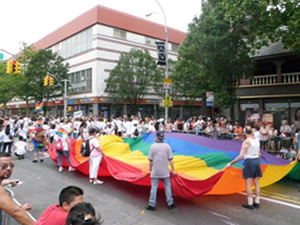The Beginning
As diverse as Jackson Heights is now, it’s surprising that at one point in time, it was designated only for the affluent caucasian. When the garden apartments were constructed by the Queensboro Corporation in the 1920’s, the corporation’s president, MacDougall, took great interest in architecture, sunlight, ventilation, and spacing. The apartments were made of solid brick, and featured tile roofs, fireplaces, large lawns, and garages.
With a prosperous postwar economy and a subway line that was built in the area for easy access, MacDougall increased the prices of the homes. Jackson Heights was advertised as a “restricted” neighborhood for wealthy professionals. Ultimately, the Anglo-Saxon Protestants occupied the location. The success garnered prompted the Queensboro Corporation to construct even more apartment buildings, each which was more successful than its predecessor. Rents doubled over the course of only a few years. In between 1923 and 1930, the population increased from approximately 3,800 to 44,500.
During the Great Depression, Jackson Heights became less attractive due to growing tensions between tenant-owners and the Queensboro Corporation. Although many residents had paid their mortgages, many were in financial despair and began to leave.
New Era
It wasn’t until the 1950’s when a new wave of young families arrived. New buildings were erected and once the immigration quotas were annulled, the neighborhood slowly became a magnet for immigrants from all over the globe. The diversity that we see now drew its origins due to the 1965 Immigration Act. Specifically Asians came in large numbers and settled. The first wave of immigrants consisted essentially of professionals such as engineers and doctors. In the 1970’s, because of the Family Reunification Act, entrepreneurs entered the country. As time progressed, taxi drivers, small business owners, garment factory workers, cart owners, and other laborers came in.
Because of Jackson Height’s subway network, affordable housing, beautiful gardens, unique architecture, and its expansive shops and restaurants, it has attracted many immigrants. However, just like every neighborhood, as various cultures begin to pour in, the surroundings begin to change. The land is molded in favor of the different ethnicities. Take for example, the South Asian commercial district on 74th Street. It is quite common to see exotic spices, nuts, sweets, and dishes. However, it is also common to see people who are not of South Asian decent eating them. Similarly, there are many shops that appeal to Hispanics, such as “Delgado Travels,” but many Asians are eager customers nonetheless. The same applies for East Asians who have set up massage and acupuncture parlors as well as restaurants that cater to Koreans, Chinese, and Japanese but get many other customers. 
Even the New York City has taken this diversity into account. Jackson Heights is not only a place for these elaborate shops, but for people who sell food in shopping carts, day laborers, people who offer various services like mechanics, and people who sell goods such as religious objects, trinkets, and books, on stalls. Some may not even have permits, but the police are aware and quite lenient.
Connecting to the Homeland & Conflict
One of the most common types of stores in Jackson Heights is one where people send money back to their homeland. Many immigrants leave their old country due to a hope for a better financial status. However, since not all members of the family come to the United States, many immigrants constantly send money back home. 
A physical transaction is not the only thing that connects immigrants to their homeland. Their mentality is also a bridge. Jackson Heights is known for its diversity, but its diversity has led to conflict. Suketa Mehta, a New York-based author, recalls her childhood in Jackson Heights in an interview. Mehta claims that when Jackson Heights was just beginning to get populated by South Asians, many residents were reluctant to accept the newcomers. During the Iranian Hostage Crisis, an Irish boy heckled her for being an immigrant. Mehta describes Jackson Heights as a hostile environment when Asians were a minority in the area. As time progressed, and the area diversified, many immigrants became second and third generation. Thus, people grew more accepting of each other.
However, this does not mean that the neighborhood is at peace. There is still a tension between the Muslims and Hindus that can be traced back to the tensions between Pakistan and India. The same can be said about the tensions between the Koreans and Japanese. Although, residents in Jackson Heights do not live in those countries, they are still emotionally connected to their roots.
Diversity is Not Limited to Ethnicity
Jackson Heights is not entirely liberal. However, it has matured as a neighborhood and is generally welcoming. This is one reason why it appeals to its growing gay community. There are many gay nightspots on Roosevelt Avenue such as Friend’s Tavern and Club Atlantis. Not to mention, it sponsors an annual gay rights parade. Yet even so, many are reluctant to accept this gay community and conflict as ensued on certain occasions.

For example, during the first gay parade in 1993, a police helicopter was necessary to prevent any violence. In addition, in 1990, Julio Rivera, a gay man from Colombia was stabbed to death because of his sexual orientation. Even more recently, in 2010, a gay man reported to the police that bouncers at a Mexican restaurant taunted him because of his sexuality and then beat him.
References:
Collins, Andrew. Queens Gay Pride 2012. 15 May 2012 <http://gaytravel.about.com/od/previewsofpridefestivals/qt/Queens_Gay_Pride.htm>.
Jackson Heights Beautification Group. History of Jackson Heights. 15 May 2012 <http://www.jhbg.org/history/history.html>.
Lippincott, E. “An Antigay Attack Rekindles Ever-Present Fears.” 2 September 2001. 15 May 2012 <http://www.nytimes.com/2001/09/02/nyregion/neighborhood-report-jackson-heights-antigay-attack-rekindles-ever-present-fears.html>.
Urban Omnibus. A Walk Through Jackson Heights with Suketu Mehta. May 2012 <http://urbanomnibus.net/2011/02/a-walk-through-jackson-heights/comment-page-1/#comment-125379>.





